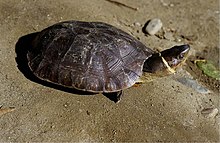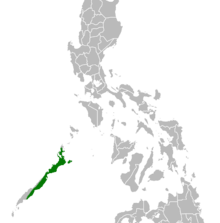| Philippine forest turtle | |
|---|---|

| |
| Profile of Philippine forest turtle | |
| Scientific classification | |
| Domain: | Eukaryota |
| Kingdom: | Animalia |
| Phylum: | Chordata |
| Class: | Reptilia |
| Order: | Testudines |
| Suborder: | Cryptodira |
| Superfamily: | Testudinoidea |
| Family: | Geoemydidae |
| Genus: | Siebenrockiella |
| Species: | S. leytensis
|
| Binomial name | |
| Siebenrockiella leytensis (Taylor, 1920)
| |

| |
| Known areas of occurrence of Siebenrockiella leytensis.[3] | |
| Synonyms[4] | |
| |
Siebenrockiella leytensis is a species of freshwater turtle endemic to the Philippines. It is classified as critically endangered.[1] It is known as the Philippine forest turtle, the Philippine pond turtle, the Palawan turtle, or the Leyte pond turtle. Despite the latter common name, it does not occur in the island of Leyte but is instead native to the Palawan island group.[5][6] It is locally known as bakoko in Cuyonon.[7]
Philippine forest turtles are readily recognizable by their ginkgo-shaped vertebral scutes and a pale white to yellow line traversing across its head behind the ears. The previous characteristic has earned it the nickname of 'bowtie turtle'.
Philippine forest turtles are classified under the subgenus Panyaenemys. Together with the smiling terrapin (Siebenrockiella crassicollis), it is one of the two species in the genus Siebenrockiella.
- ^ a b Schoppe, S.; Diesmos, A.C.; Diesmos, M. (2021). "Siebenrockiella leytensis". IUCN Red List of Threatened Species. 2021: e.T39599A2929929. doi:10.2305/IUCN.UK.2021-1.RLTS.T39599A2929929.en. Retrieved 11 November 2021.
- ^ "Appendices | CITES". cites.org. Retrieved 2022-01-14.
- ^ Pierre Fidenci & Reymar Castillo (2009). "Some Data on the Distribution, Conservation Status and Protection of Freshwater Turtles in the Palawan Island Group, Philippines". British Chelonia Group: Testudo. 7 (2). British Chelonia Group: 76–87.
- ^ Fritz Uwe; Peter Havaš (2007). "Checklist of Chelonians of the World" (PDF). Vertebrate Zoology. 57 (2): 248–249. ISSN 1864-5755. Archived from the original (PDF) on 2011-05-01. Retrieved 29 May 2012.
- ^ Pierre Fidenci & Jérôme Maran (2009). "Illegal Domestic Trade of the Philippine Forest Turtle (Siebenrockiella leytensis) in the Philippines" (PDF). TurtleLog (3). IUCN/SSC Tortoise and Freshwater Turtle Specialist Group: 1–3. doi:10.3854/tln.003.2009. ISSN 1947-7635. Retrieved July 29, 2011.
- ^ Ellalyn B. De Vera (March 28, 2011). "Local forest turtle (Siebenrockiella leytensis) getting extinct". Manila Bulletin. Retrieved July 29, 2011.
- ^ Schoppe, Sabine; Acosta, Diverlie (August 2016). Philippine Freshwater Turtle Conservation Program (PFTCP) 2015 Annual Report (PDF). Katala Foundation.
